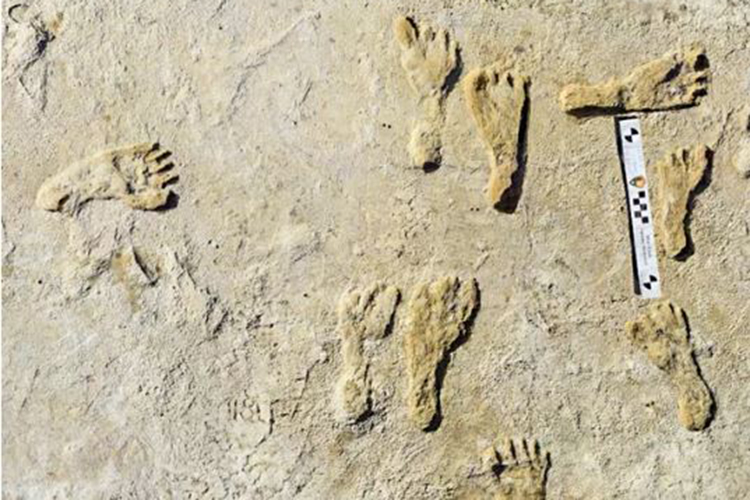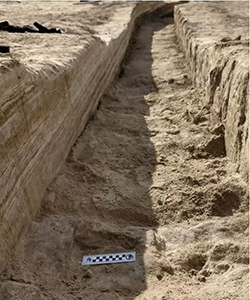
Soil rich with gypsum helped preserve human footprints from some 23,000 years ago at what is now White Sands National Park. (Photo courtesy of the National Park Service)
Millennia ago, before the pyramids were built, before the development of pottery, before mammoths and mastodons went extinct, children were splashing in puddles on the shores of paleo-lake Otero in the Tularosa Basin.
Nearby, a mother walked along the shore, holding a baby on one hip. A hunter stalked his prey. Behind them, they left tracks in the mud, which was rich with gypsum – a mineral that today is used in plaster casts. The gypsiferous soil, combined with the right level of water and clay, ensured those footprints remained pressed into the ground.
Over thousands of years, gypsum from the nearby San Andreas Mountains washed into the basin and crystallized as Lake Otero slowly dried up. The crystals eroded into fine grains of white sand, covering the tracks completely.
Then, 23,000 years later, the footprints were uncovered once more, thanks to erosion. These now-fossilized tracks are the oldest-ever human footprints discovered in North America. A team of archaeologists at White Sands National Park in New Mexico began excavation on the site in 2020 and publicized their findings in late 2021.
“It completely changes our perception of the peopling of the area,” said Clare Connelly, a UWM alumna and one of the archaeologists on the excavation team. “Before our (discovery) came out, it was believed that people weren’t in that area until 16,000 years ago.”
But more than that, seeing the footprints has driven home that people once lived here.
“You can look at an artifact and you can guess what it was like to make that artifact,” Connelly said. “But you look at these footprints, and you can see kids splashing in puddles. You can see the way an individual’s hip is turned because they’re carrying a child. With the way that their foot is pressed, you can see someone hunting. You don’t have to guess. And that’s just so cool.”
A journey to White Sands
Connelly has long been interested in archaeology and history. After earning a bachelor’s degree anthropology at the University of Ohio, Connelly came to UW-Milwaukee for graduate school, eager to study under distinguished professor of anthropology Bettina Arnold.

Researchers dug trenches while excavating the footprints. (Photo courtesy of the National Park Service)
While at UWM, Connelly got an internship with Death Valley National Park and fell in love with the U.S. National Park Service.
“From then on, I decided I was going to be a jack-of-all-trades archaeologist and learn whatever tools I needed to be able to work for the Park Service,” she said.
Her first job was with the Midwest Archaeological Center, a division of the National Parks which contracts to help federal agencies with their land and cultural resource management. From there, she held museum positions in North Dakota and Texas before she was hired at White Sands National Park in 2020.
The job was everything Connelly could have hoped for.
“My first day (I) was hunting mammoth tracks,” she said, laughing. (She and the intern leading the hunt did end up finding them – they look like huge circles, Connelly said.)
White Sands is full of fossilized tracks that are all thousands of years old: mammoths and mastodons, canines and felines, human, camel and even giant sloth. Connelly was hired in part to help excavate the human footprints. As part of her job, she’s working with the descendants of the people who made those early tracks.
“We work with dozens of tribes and pueblos who are connected to this land. They have a lot of history here,” Connelly said. “They’re literally walking in their ancestors’ footprints.”
In addition to excavating fossils and liaising with the Indigenous community, Connelly is responsible for all of the archaeological work in White Sands National Park. That means she’s in charge of the site’s museum program, its compliance with federal guidelines, the park’s geographic information systems program, and “everything that is in any way connected to cultural resources,” she said. “It’s very common in the Park Service to wear a lot of hats.”
She and the footprint excavation team are also waiting on some new dating information to find out more about those 23,000-year-old fossilized tracks.
A significant discovery
The footprints were discovered by accident in 2009. A young boy had gotten lost in the park. As he was helping look for the missing child, David Bustos, the resource program manager at White Sands National Park and now Connelly’s boss, stumbled across some fossilized footprints that looked to be human. After the boy was found safe, Bustos called in experts from around the globe to help him excavate what would turn about to be the oldest-known fossilized human footprints in North America.
Connelly was hired after the discovery, but she has helped excavate the site and studied the surrounding areas to understand what the environment might have been like when the footprints were made. While the oldest do date back 23,000 years, some tracks are as “young” as 10,000 years old. Using carbon dating, the other researchers can estimate the age of the footprints based on the age of the surrounding organic material, like seeds and soil.
And who knows, Connelly added – it could be that there are even older footprints in the area that just haven’t been uncovered yet. The researchers are still digging in hopes of learning more about how the American southwest came to be populated.
But one thing is certain: No matter when they lived, some things about humanity are universal.
“You’ll look at these footprints, and you can see kids splashing in puddles. And that’s just so cool,” Connelly said. “It’s just so human. Children are always going to jump in puddles when they see them.”
Written by Sarah Vickery
Link to original story: https://uwm.edu/news/alum-helps-uncover-oldest-ever-human-footprints-discovered-in-north-america/

